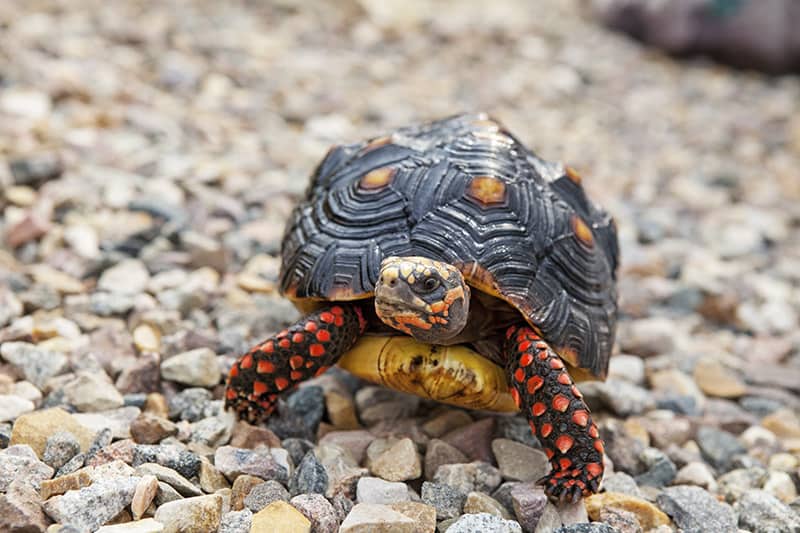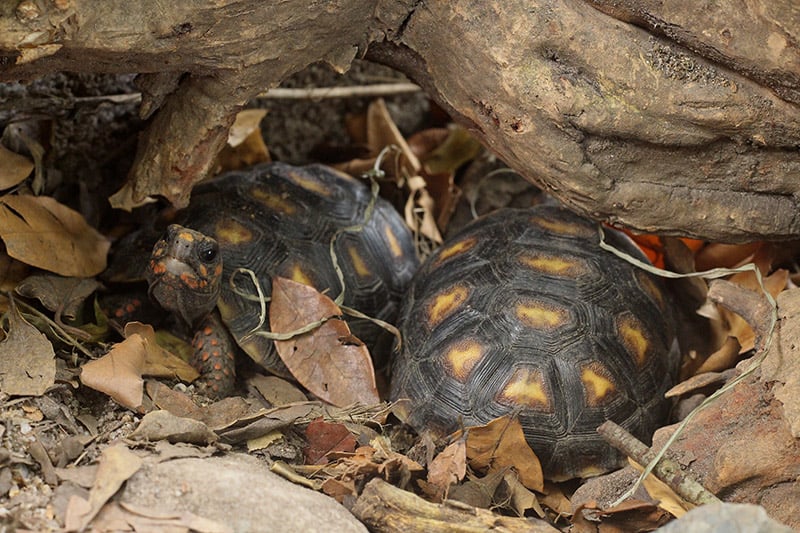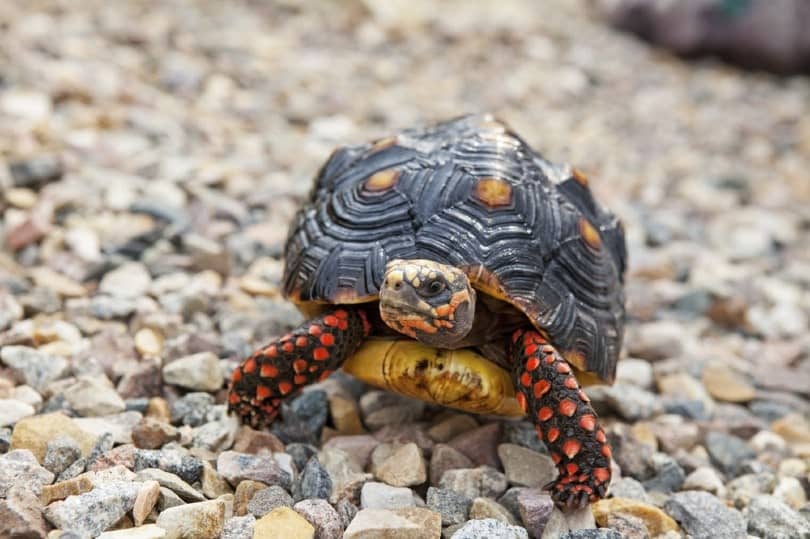A medium-sized tortoise, the popular Red-footed Tortoise is considered to be one of the most responsive and personable of the tortoises!
The Red-footed Tortoise, also sometimes called the Red-leg Tortoise or Savanna Tortoise is described as one of the best pet tortoises. They are typically outgoing and curious. Besides staying relatively small they are colorful, hardy, and long-lived.
- For more information see: Selecting and Caring for Your Turtle or Tortoise
Scientific Classification
| Kingdom: | Animalia |
| Phylum: | Chordata |
| Class: | Reptilia |
| Order: | Testudines |
| Family: | Testudinidae |
| Genus: | Geochelone |
| Species: | carbonaria |
Distribution
Red-footed Tortoises are found in the tropical and humid forest areas of South America. They inhabit Guianas, Venezuela, Brazil, Ecuador, Paraguay and there are some on the Caribbean islands. They live in the underbrush and forage for fallen fruit, plant growth, and will even eat carrion.
Status
This tortoise is not listed on the IUCN Red List of Threatened Species but is listed on CITES: Appendix II.
Description
One of the most colorful tortoises, the skin and carapace (upper shell) of the Red-footed Tortoise is dark brown to black with lighter patches in the centers of the scutes and around the edges, usually a yellowish tan or red color. The plastron (bottom shell) is a bland yellowish brown, sometimes with a hint of red. A few or sometimes many of the scales on the front legs, as well as patches on the head are orange, yellow, or red. Due to the large natural range they originate from, this coloring can be quite variable from one tortoise to the next.
A descriptive characteristic of the Red-footed Tortoise is their adult body shape, more pronounced in the male than the female. The sides of the carapace become concave, almost giving it a ‘waist’. The shape of the shell is often described as a loaf of bread or an hourglass. A medium size tortoise, they stay relatively small growing to about 12″ to 16″ (30 – 40 cm) for most types. The male is slightly larger than the female and has a longer, wider tail.
On the juvenile Red-footed Tortoise, the carapace is lighter. It has a pale yellowish background color that develops into darker patches as it matures.

Care and Feeding
Red-footed Tortoises are omnivorous, eating both animal and plant material in nature. In captivity they will feed eagerly on a mixed salad of fruits and vegetables every other day. They should be fed some higher protein items once or twice a week. Most Red-footed Tortoises will eagerly feed on dead mice and dead chicks, but some prefer to feed them a high-quality commercial food once a week. Mazuri Tortoise Diet® and Zupreem Primate Diet® (“Monkey Biscuits”) are great supplements to their diet.
Water should be offered in a large flat saucer. This can be a cat litter pan sunk into the substrate (make sure the tortoise can climb in and out easily) or a large plastic saucer which is normally placed under a potted plant. These can be easily cleaned and sterilized once a week or as needed.
Environment
Red-footed Tortoises require warm, humid environments. A pair of adults will require an enclosure that is at least 4′ wide x 6′ long.
The substrate can be a mixture of ½ sand and ½ peat moss. A layer of cypress mulch can be placed over the top of the substrate to help hold in moisture. The addition of piles of dry leaves, hay, and plants in pots can add to the natural look of a Red-foot enclosure.
A variety of shelters can be offered to give the young Red-footed Tortoise a feeling of security. Add large pieces of curved cork bark, large banana leaves, piles of hay, or grass clippings for the tortoises to use as shelter. The shelter should be located at the cooler end of the enclosure and not directly under the heat-emitting lamps.
Provide heat using a heat-emitting bulb in a clamp-type fixture over the enclosure. Ideally, you can hang a fixture overhead that will hold the bulb and keep it about 12″ above the surface of the substrate. Most of these bulbs get very hot and so should be kept in a fixture with a ceramic base. The heat-emitting bulbs should provide a basking spot of 90{deg} F (32{deg} C) at one end of the enclosure. The heat in this area will allow the Red-footed Tortoise to bask and to digest its food properly.
Lighting can be provided with a shop light fixture overhead that is fitted with one or two UV-emitting bulbs. These can be found at your pet store or on-line from a variety of sources. UVB-heat bulbs® from T-Rex products and Zoomed Reptisun® bulbs will provide UV radiation to the enclosure. This UVB is necessary for Vitamin D3 synthesis, which allows the tortoises to properly use calcium and to carry on metabolism.
Indoors
A glass terrarium works well for small and medium sized Red-footed Tortoises. A young tortoises can be kept in a 20-gallon long terrarium (20″ l x 12″ w x 12″ h) while a medium tortoise will need a 40-gallon breeder terrarium or larger. Tape paper on the back and sides of glass terrariums to keep the young tortoise from constantly trying to walk through the clear glass.
You can also use plastic tubs, wooden cages, and other enclosures; but glass terrariums are easy to find at the local pet store and they come in a variety of sizes. Of course, as the tortoise grows, it will need larger and larger enclosures.
Outdoors
All tortoises benefit from being kept outdoors for all or part of their lives. They received doses of UVB radiation, environmental heat, and of course enjoy a connection to the grass, plants, and soil found in outdoor pens. Outdoor enclosures should offer shelter from heat, a secure place to rest, and a water source. Feed outdoor tortoises three times a week and at their leisure they can eat some of their favorite grasses, fruits, and vegetables within the enclosure. Also be very diligent to make sure that outdoor enclosures are escape-proof and predator-proof.
Red-footed Tortoises require warm, humid environments. If you live in an arid area, you will need to offer mud wallows or will need to turn on the water sprinkler once a day, especially during midday heat.

Handling
Red-footed Tortoises are typically outgoing and curious. They can be hand-fed and strawberries, pieces of melon, and hibiscus flowers are some of their favorite treats. They usually won’t retreat into their shells but will look around to see what is going on.
Specimens that have been raised from small, captive-hatched babies and which are open to daily interaction over many years become the most tame and easily handled. You should however, provide a variety of shelters to give these tortoises a feeling of security.
Breeding
An established pair of Red-footed Tortoises can be very prolific and in warm areas can produce year-round. A light winter cooling, followed by warm, rainy days triggers breeding in Red-footed Tortoises. Males are very eager breeders and a healthy pair can produce two to four clutches of 3 to 4 eggs each season, depending on the size of the female.
It is felt by most keepers that the addition of protein and calcium to a female Red-foot’s diet is essential in having her produce clutches of healthy, viable eggs. The young Red-foots hatch out in approximately 100 days at 82{deg} to 84{deg} F
Ailments / Health Problems
As with most other tortoises Red-footed Tortoises are found in warm habitats. Thus, their captive enclosures should reflect this need. When kept cool for an extended period of time, you can expect a Red-footed Tortoise to begin showing respiratory problems. The early signs are puffy eyes, runny noses, etc. You should strive to maintain an enclosure that is hot and humid (but not soggy) to avoid these health issues.
Be Aware:
REMEMBER: Ivermectin, a famous wormer in the cattle industry, |
Long-term lack of appetite, runny or smelly stools, and blood in the feces are signs of a problem and a keeper should approach a qualified veterinarian if any of these signs are noticed.

Availability
Red-footed Tortoises are readily available from better reptile stores, on-line, or at reptile shows and expos.
Try to purchase your tortoise from a breeder or someone with intimate knowledge of tortoises. Be careful when purchasing a tortoise on-line. There are many many imported “farm-raised” Red-footed Tortoises arriving into the pet trade (see ailments above). These animals are not necessarily the best for beginning keepers.
Captive-hatched animals from a breeder are excellent animals for a beginner. A breeder will help you set up the proper enclosure and will give you helpful hints so you are successful. Also, if you don’t have to ship your tortoise, that is always best. A beginning keeper should purchase a tortoise that is at least three months old to make sure it is past the delicate stage.
Featured Image Credit: Brenda Carson, Shutterstock
